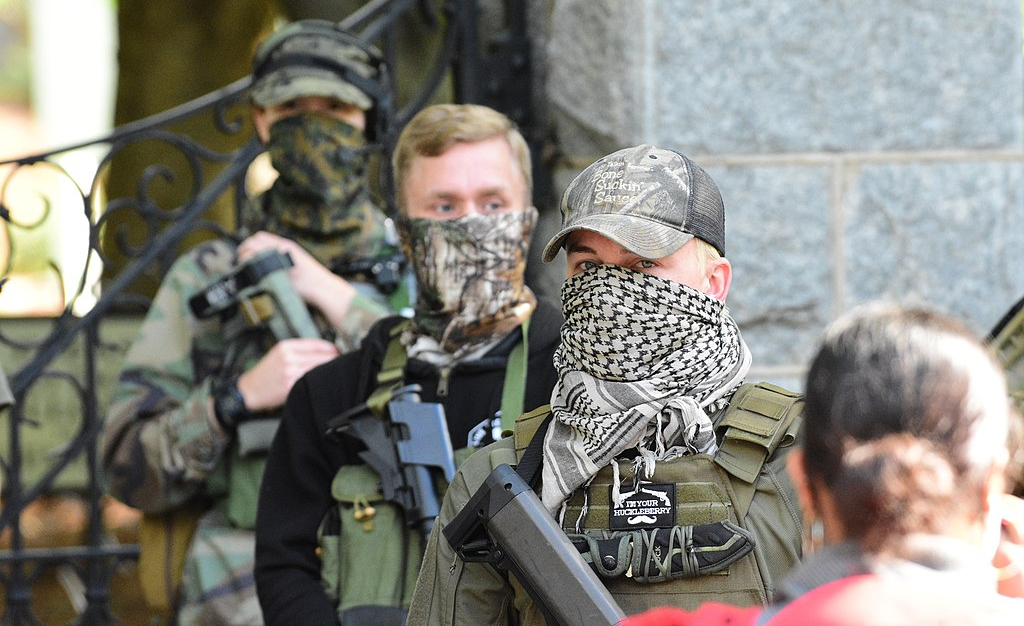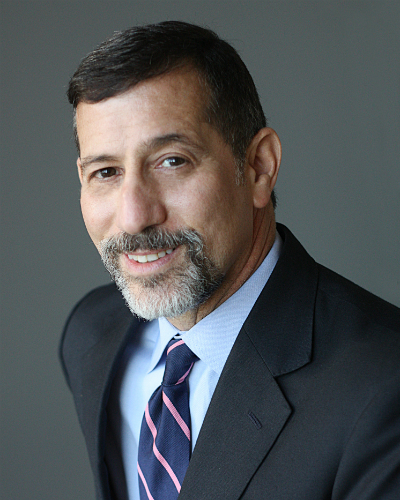The Terrorist Threat from the Fractured Far Right
Surveying the wide array of groups and ideologies that have emerged over the last few years.

Published by The Lawfare Institute
in Cooperation With

Editor’s Note: The year 2020 has produced many shocks, including numerous threats of political violence. Bruce Hoffman, my Georgetown colleague who is also a senior fellow at the Council on Foreign Relations (CFR), and Jacob Ware of CFR argue that the right-wing threat is fracturing, with a wide range of overlapping groups and radical individuals posing a risk of violence that may overwhelm counterterrorism officials.
Daniel Byman
***
In November 2019, Seamus Hughes and Devorah Margolin of the George Washington University’s Program on Extremism argued here on Lawfare that the jihadist threat to the West has splintered. “It is clear that the jihadist threat has become fractured, with new and old hazards facing the United States concurrently,” they reasoned, before presenting the multiple different groups—including homegrown jihadists, returnees from conflicts abroad, and those recently released from prison—that have diversified the threat beyond the traditional conceptualization of hierarchical, bureaucratic, foreign-based terrorist organizations that send foreign fighters abroad, à la al-Qaeda in September 2001. They are right, but this atomization of terrorism is not confined to the jihadist threat.
Over the past few years, and especially the past few months, the far-right extremist movement has fractured, too. It now presents a more disparate, amorphous and, arguably, dangerous threat than before. The challenges to law enforcement and intelligence agencies tracking this diverse and evolving movement are formidable, particularly their efforts to preempt and interdict attacks from so wide an array of adversaries. Between the ongoing challenges of monitoring al-Qaeda and Islamic State attack planning in the United States, coupled with mounting instances of anarchist and other left-wing violence, authorities face an unprecedented deluge of threat information and intelligence. The threat has been complicated further by this critical moment in U.S. history, which has included a global pandemic and rolling, nationwide protests against police brutality.
Until recently, Western states faced primarily white supremacist threats from lone actors—as displayed to heartbreaking effect from Norway to New Zealand. But a heterogeneous collection of extremist actors within the same broad ideological community has now emerged, all seeking to press their own unique agendas and independently pursue their own strategies to undermine and eventually destroy the Western liberal state system.
Most worryingly, it is now almost impossible to deduce which group or networked individual poses the most pressing threat, which communities are in imminent danger, and against whom counterterrorism resources should be arrayed most urgently.
White Supremacists and Neo-Nazis
That the far-right poses the most salient terrorist threat is no longer up for debate—the Anti-Defamation League found that what they broadly categorize as right-wing extremists were responsible for 90 percent of extremist-related killings in 2019. Recently, the Department of Homeland Security stated similarly that homegrown white supremacist and neo-Nazi terrorists present the clearest terrorist danger. FBI Director Christopher Wray also confirmed the threat in testimony before the House Committee on Homeland Security in September. “Within the domestic terrorism bucket, the category as a whole, racially motivated violent extremism is, I think, the biggest bucket within that larger group,” Wray explained. “And within the racially motivated violent extremist bucket, people subscribing to some kind of white supremacist-type ideology is certainly the biggest chunk of that.”
Between late 2018 and early 2020, the Western world was forced belatedly to broaden its two-decade-long preoccupation with Salafi-jihadist terrorism to include the rising threat from white supremacist and neo-Nazi violence—as the shootings in Pittsburgh, El Paso, Christchurch and elsewhere demonstrated repeatedly. Whereas those attacks were perpetrated by so-called “lone actors,” the parallel emergence of several neo-Nazi groups and networks, most notably the Atomwaffen Division and the Base, has also occupied law enforcement. Though they have been disrupted by arrests and internal divisions, the embers of these organizations continue to pose a threat. And, as with Salafi-jihadists, questions endure about how to deal with those who have been released from prison—especially given that many of the prosecuted members of the Atomwaffen Division and the Base were sentenced to comparatively shorter prison terms for similar crimes.
“Boogaloo” and Anti-government Extremism
One of several movements straddling the online-offline divide, boogaloo boys (or “bois”) have played an increasingly visible role in the wake of the George Floyd protests. Known for wearing colorful Hawaiian shirts—a play on an alternative moniker, “big luau,” used to evade online moderation—they have congregated at protest sites, usually heavily armed. These radicals await or actively plan for what they call the coming boogaloo (or “big luau” or “big igloo”)—a new American civil war. Although the ideology first surfaced around 2012, until recently the boogaloo movement lurked around the fringes of the internet and was not popularly known. That has changed in the runup to the 2020 presidential election as a growing number of boogaloo adherents have responded to government-enforced coronavirus lockdowns in some states and municipalities and protests over George Floyd’s killing.
Boogaloo bois were responsible for the worst terrorist incidents and plots in the United States this past summer. Most notably, in late May and early June, a federal security officer and a sheriff’s deputy were killed in shootings perpetrated by an active-duty Air Force sergeant. At the second scene, the wounded gunman wrote “boog” in his own blood on a car. In Nevada, three boogaloo bois were arrested for planning to terrorize Las Vegas protests. And in October, 14 anti-government extremists were arrested in an alleged plot to kidnap—and put on trial in a kangaroo court—Michigan Governor Gretchen Whitmer; Virginia Governor Ralph Northam was also targeted in the conspiracy. The online names used by several of the militiamen on social media suggest that they embrace the boogaloo ideology.
To be clear, not all boogaloo advocates are white supremacists or on the extreme right—many stood with Black Lives Matter protesters after Floyd’s killing, emphasizing shared opposition to law enforcement over racial barriers. Despite their different ideological perspectives, boogaloo bois are united in their disdain of government authority and hatred of the police. Their common goal is to bring down the existing government and replace it with an ill-defined anarcho-capitalist system. Though their long-term goals are not well defined, their lineage can be traced to the broader pro-militia, zealously Second Amendment, anti-government subculture that has produced terrorists like Timothy McVeigh, the infamous 1995 Oklahoma City bomber. As such, they pose a considerable threat to government and law enforcement targets—a threat that may intensify in the event of a disputed election. Boogaloo bois often appear at rallies and protests wearing body armor and combat webbing, and carrying assault weapons and side arms. Their repeated claims that they are waiting for some signal or opportunity to commence a guerrilla-style insurrection cannot be ignored or dismissed given the recent surge in attacks and foiled plots.
Amplifying the threat, many anti-government groups, including militias such as the Three Percenters and the Oath Keepers, have actively recruited from the U.S. military. In the wake of protests and shootings in Kenosha and Portland, the leader of the Oath Keepers declared “civil war is here, right now”—a call to arms that got pages affiliated with his group removed from several social media sites. Founded in 2008, Three Percenters take their name from the false claim that only 3 percent of the population of the American colonies fought against the British during the Revolutionary War. Their website denies that the group is racist or white supremacist, or even a militia; it claims that it is not a seditious movement but asserts instead that its “goal is to utilize the fail-safes put in place by our founders to rein in an overreaching government and push back against tyranny.” Nonetheless, over the past few years, persons linked to the Three Percenters have been arrested on a variety of violence-related charges.
The Proud Boys, a militant far-right group known for provoking street brawls with far-left and anti-fascist rivals, present another threat from the far-right. The group has yet to engage in terroristic violence, but President Trump’s call to “stand by” during the first presidential debate gave the group both attention and credibility that has resulted in a surge of new members amid intensifying calls to action as Election Day approaches.
QAnon
QAnon—the conspiracy theory spreading across the United States, and now through countries in Europe and elsewhere—maintains that President Trump is saving the world from a Satan-worshipping pedophilia ring run largely by Democrats and Jews. Its credulous adherence to, and spreading of, the most outlandish conspiracy theories poses a new and unpredictable potential terrorist threat. The movement has already led to violence. For instance, in March 2019, Francesco Cali, a leader in the New York Gambino crime family, was murdered by a QAnon supporter, who believed Cali was part of “the deep state” and working to undermine the president.
Although QAnon adherents stray into white supremacism, as evidenced by the repetition of long-standing anti-Semitic dog whistles hinting at a cabal of wealthy, shadowy Jews running the world, the immediate threat does not seem to be directed specifically against persons of color, immigrant groups or Jews. Any violence would likely involve targets emblematic of the movement’s conspiratorial world view—including liberals, Democratic politicians or, as in Cali’s case, their perceived accomplices. The “Pizzagate” shooter who opened fire at the Comet Ping Pong restaurant in Washington, D.C., in December 2016—believing a child sex trafficking ring was being run in the basement—may prove to be a model of future violence. In another possible precedent, a female QAnon supporter from Illinois was arrested in May, having traveled to New York to “take out” Democratic candidate Joe Biden.
With estimates of QAnon followers ranging from the low hundred thousands to the low millions, it presents, like the boogaloo movement, an uncertain and volatile threat if the election results do not favor Trump—particularly if there is any perception of foul play and if the president amplifies allegations of electoral fraud.
Neo-Luddites
In January, before the full force of the coronavirus pandemic hit the West, terrorism scholar Colin Clarke warned that “neo-Luddites”—individuals motivated by Unabomber-like theories about technological advancement and the degradation of society—might present an additional terrorism threat. The prediction has proved accurate. Over the past several months, a number of violent incidents have been attributed to these extremists. Attacks have been mounted against hospitals and health care facilities—most notably, one neo-Nazi killed himself during a shootout with authorities who foiled his effort to detonate an explosive at a Missouri hospital—while 5G technology, which some extremists link to the spread of the virus, is also increasingly threatened.
The novel coronavirus has had a particularly strong impact in empowering and publicizing anti-modernity causes, most clearly visible in the emergence of armed anti-lockdown and anti-mask protests. Beginning in Lansing, Michigan, in April, armed groups that refuse to accept the scientific consensus on the coronavirus have descended on state capitols to protest stay-at-home orders—sometimes encouraged by the president, most notably through his “LIBERATE” tweets aimed at various states. These groups benefit from a confluence with anti-government movements that see mask mandates as the latest manifestation of tyrannical government overreach. This overlap is evidenced by the frequent appearance of the bright yellow “Don’t Tread On Me” Gadsden flag at such protests.
The threat from neo-Luddites, including the anti-vaccine movement, may intensify as a coronavirus vaccine becomes widely available, or should new lockdowns or sustained mask-wearing mandates take effect.
“Salad Bar” Ideologies
One of the defining features of the ongoing wave of far-right violence has been what we call ideological convergence, or what Daveed Gartenstein-Ross and Madeleine Blackman term “fringe fluidity” and a senior FBI official has described as “salad bar” ideologies. These terms describe the blending of different extremist ideologies—incels adopting white supremacist language and iconography, fascists claiming concerns about environmental degradation, the far-left and the far-right coming together to protest police violence and advance militant anti-government positions, and even accelerationist neo-Nazis worshipping jihadist pioneers such as Osama bin Laden. Convergence has continued apace amid the coronavirus and social justice protests—for example, in September, two boogaloo bois were arrested for providing material support to the terrorist organization Hamas.
Perhaps the most imminent threat within this category is posed by eco-fascism—an ideological mélange that has already inspired major white supremacist attacks in Christchurch and El Paso. Eco-fascists argue that only white supremacism can stop environmental degradation and save the planet. They propose limiting Western societies to the white race in order to decrease the population and the burden on the climate, and they embrace the Nazi ideological tropes of lebensraum (living space) for the white race and the blood and soil criticality of civilization. Eco-fascists are obsessed with the survival of the Nordic race and often worship the old gods of Thor (lightning, storms and trees) and Sunna (the sun), are patently anti-Semitic, and deny that the Holocaust occurred.
Convergence provides a unique threat because it confuses counterterrorism defenses, eroding predictability and challenging law enforcement and intelligence categorizations. When authorities cannot easily define an adversary’s ideology, pinpoint grievances, or identify a likely recruitment pool, it is much more difficult for them to adequately prepare countermeasures, let alone warn and defend potentially targeted communities and sites. It also makes it impossible to predict possible extremist alliances. In a world where U.S. anti-government extremists are plotting to collaborate with a decades-old Palestinian militant group, or where neo-Nazis are inspired to action by climate change, seemingly any combination of militants and extremist causes is possible.
Confronting the Fracturing Far-Right Terrorism Threat
The fracturing far-right is not necessarily new. The United States has always faced a diffuse militia and anti-government threat, and throughout the latter parts of the 20th century, the extreme right’s efforts to unify unraveled under intense law enforcement pressure. The result was a disparate, splintered movement, with skinheads, national socialist movements, and militias all competing for recruits and attention. But today’s atomized movement is different—not least because of the connectivity afforded by the internet and social media. It is also fueled to a greater extent than before by increasingly widespread populist discontent in the United States and in other Western countries that has been increasingly legitimized by political leaders and thus entered into the mainstream of national politics and discourse. We are not just seeing several factions energized; we are also seeing them unusually vocal, unnervingly popular and, in some cases, unconventionally public in their promises of violence.
Until a few months ago, far-right violence was mostly predictable. Instances tended to be tragic but otherwise largely contained shootings randomly perpetrated by lone-actor white supremacists against soft targets—typically places of worship or shopping centers—along with sporadic militia or sovereign citizen attacks on law enforcement. We now face a cacophony of violence, growing louder and perpetrated by multiple collectives or groups of actors that are similar in their ideologies and strategies, but just distinct enough in their differing approaches and targeting to complicate counterterrorism efforts.
Although these groups have so far inflicted a limited number of fatalities, their violence has the potential to escalate suddenly. And there seems to be no clearly articulated strategy from either the federal government or law enforcement to wrench back control. The 2020 election provides the most dangerous potential trigger, particularly in the event of a contested outcome. Several of these groups, including QAnon adherents, are highly motivated by President Trump; any appearance of voting irregularities that favor the Biden campaign against Trump, whether legitimate or not, may spark widespread violence—especially if the president chooses to amplify such concerns. But predicting which of these groups is most likely to attack and what targets would be most in danger is not possible. In the absence of a clear, comprehensive national strategy, fear and anxiety is increasingly fueled by uncertainty and discord.
There is no telling where the next bullet or bomb will come from, but it could trigger a wave of domestic terrorism, with a variety of disparate actors standing armed and ready.






